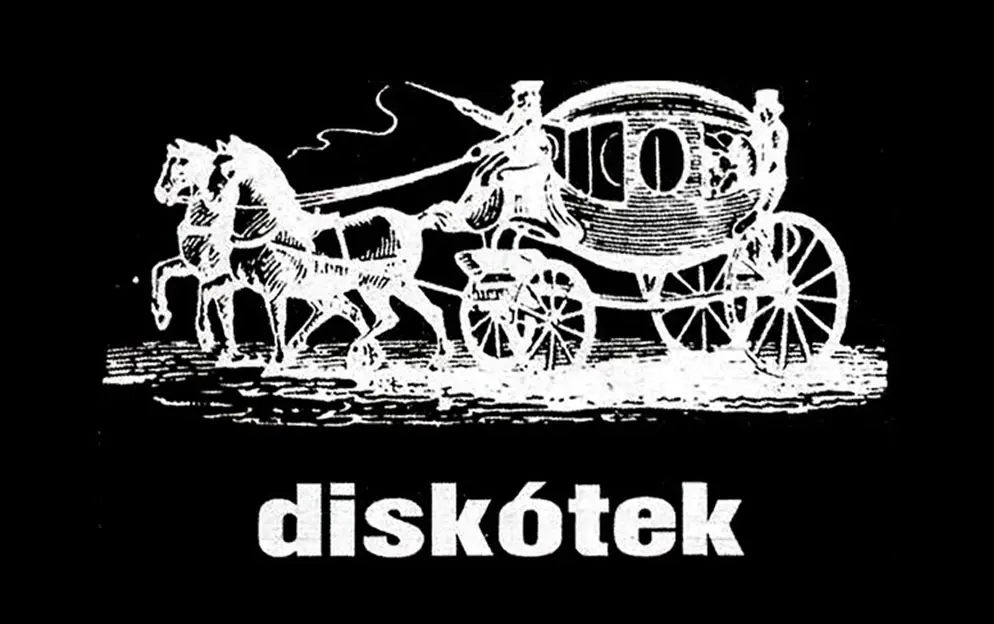
Arnfinnur Amazeen‘s exhibition, Discotheque, presents new works that draw inspiration from the ambiguous imagery of Icelandic night club culture in the seventies and eighties. While the title makes a reference to revelry, what we have here is nonetheless a rather dreary discotheque, which the artist has created in the lower gallery of Hafnarborg. There is no glitz and glamour to be found here, only the subtle indication of something that has already happened. The resounding silence of a noisy past.
The exhibition is comprised of three parts. On the walls of the gallery, there is a series of large pencil drawings, based on old night club advertisements. In the drawings, everything has been erased except select visual motives and the word “diskótek” [discotheque]. The advertisements are otherwise unidentifiable, a mere trace of past events. In the middle of the space, a mobile sculpture is suspended in the air like a thundercloud. It functions as a kind of disco ball, its form reminiscent of the rudimentary motives of the club advertisements while resembling clichéd clip art in other aspects. Instead of representing the frivolity of the dance floor, the disco ball has, however, turned into the omen of an impending storm. The gallery floor is also lined with pairs of used shoes, filling the space. This might then signal a dance, though the shoes are stuffed with multi-coloured plastic bags, alluding to the old (and perhaps typically Icelandic?) custom of wearing bags on one’s feet to keep them from getting wet.
Originally, the exhibition was supposed to open in spring 2020, being well underway when the coronavirus pandemic brought everything to a halt. Summarily, the works were set aside, to be exhibited later. Now, they have at last been brought from storage, hanging on the walls or from the ceiling, even covering the floor of the gallery, where the works all come together as one. In retrospect, the exhibition can thus be seen as a precursor of what was to come, through this past year, namely the end of all festivities and unexpected lockdowns.
From the beginning of his career, Arnfinnur has been finely attuned to the present moment. In his practice, he often works with historical material, the shared past and individual experience, in an attempt to define the present, primarily doing so for himself. Borrowing the terminology of art critic Jörg Heiser, the artist’s works could be placed in the category of Romantic Conceptualism. Arnfinnur’s works are characterized not by nostalgia alone, but by a methodical search and the conceptual presentation of vague feelings, which both underpin the present time and shape our lives.
In these times, we are continually being reminded of threats on all fronts. This feeling of imminent danger has been a recurring theme in Arnfinnur‘s works for some time now. At his last solo exhibition in Iceland, Subselves Mean Well at Reykjavík Art Museum’s D-hall Exhibition Series in 2016, this theme was especially apparent. For this work, the artist drew from various self-help books, which can be seen as a reaction to the dangers felt by mankind today.
At this moment, Arnfinnur looks to the imagery of Icelandic night club culture, as has been previously stated, studying advertisements of unknown creators, published in local newspapers in the twentieth century. There, one gazes innocently at the wider world around us. To wit, the discotheques are called Broadway, Hollywood and Evrópa [Europe]. When the “Topless Go-Go Dancer Performs Tonight”, as one advert states, one can then leave all passing worries behind, at least for a time. Here we are met with a familiar theme. Spirits are high, but at the same time everybody knows that the party will surely come to an end, soon.
Though the pandemic finally seems to be in decline, there are ever new storm clouds gathering on the horizon. And the guests will get their feet soaking wet, in the near future, if they do not have the foresight to stuff their shoes with plastic bags before the storm hits.
Curated by Heiðar Kári Rannversson, curator at North Atlantic House, Copenhagen, but he also writes the exhibition text.
Arnfinnur Amazeen (b. 1977, Akranes, Iceland), studied at the Iceland Academy of the Arts and completed postgraduate studies from the Glasgow School of Art. Arnfinnur has lived and worked in Copenhagen since 2006.
"*" indicates required fields